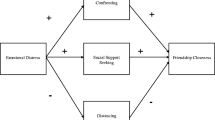Abstract
Based on reports from 143 male college students, the relationship between a dating partner's perceived level of competitiveness and combativeness (one's own and one's partner's) is examined. Competitiveness is seen as a direct measures of efforts to exert control. Findings show that even high levels of “pleasant” competitive behaviors are unrelated to combativeness. However, as scores on a measure of “unpleasant” competitive behaviors increase, so do scores on a measure of combativeness. Recommendations are offered to educators and counselors regarding the nexus between competitiveness and courtship problems.
Similar content being viewed by others
References
Arias, L., Samios, M., and O'Leary, K. D. (1987). Prevalence and correlates of physical aggression during courtship.J. Interpers. Viol. 2: 82–90.
Bernard, M. L., and Bernard, J. L. (1983). Violent intimacy: The family as a model for love relationships.Fam. Relat. 32: 283–286.
Bernard, J. L., Bernard, S. L., and Bernard, M. L. (1985). Courtship violence and sex typing.Fam. Relat. 34: 573–576.
Billingham, R. E. (1987). Courtship violence: The patterns of conflict resolution strategies across seven levels of emotional commitment.Fam. Relat. 36: 283–289.
Billingham, R. E., and Sack, A. R. (1986). Courtship violence and the interactive status of the relationship.J. Adoles. Res. 1: 315–325.
Billingham, R. E., and Sack, A. R. (1987). Conflict resolution tactics and the level of emotional commitment among unmarrieds.Hum. Relat. 40: 59–74.
Bogal-Allbritten, R. B., and Allbritten, W. (1985). The hidden victims: Courtship violence among college students.J. Stud. Person. 201–204.
Cate, R. J., Henton, J., Koval, F. S., Christopher, F. S., and Lloyd, S. (1982). Premarital abuse: A social psychological perspective.J. Fam. Issues 3: 79–90.
Deal, J. E., and Wampler, K. S. (1986). Dating violence: The primacy of previous experience.J. Social Pers. Relat. 3: 457–471.
Dibble, U., and Straus, M. A. (1980). Some social structural determinants of inconsistency between attitudes and behavior: The case of family violence.J. Marr. Fam. 42: 71–80.
Finklehor, D. (1983). Common features of family abuse. In Finklehor, D., Gelles, R. J., Hotaling, G. T., and Straus, M. A. (eds).The Dark Side of Families, Sage, Beverly Hills.
Gwartney-Gibbs, P. A., Stockard, J., and Bohmer, S. (1987). Learning courtship violence: The influence of parents, peers, and personal experiences.Fam. Relat. 36: 276–282.
Henton, J., Cate, R., Koval, J., Lloyd, S., and Christopher, S. (1983). Romance and violence in dating relationships.J. Fam. Issues 4: 467–482.
Hudson, W., and McIntosh, S. R. (1981). The assessment of spouse abuse: Two quantifiable dimensions.J. Marr. Fam. 43: 873–888.
Kalmuss, D., and Seltzer, J. A. (1986). Continuity of marital behavior in remarriage: The case of spouse abuse.J. Marr. Fam. 48: 113–120.
Kohn, A. (1986).No Contest: The Case Against Competition, Houghton Mifflin, Boston.
Lane, K. E., and Gwartney-Gibbs, P. A. (1985). Violence in the context of dating and sex.J. Family Issues 6: 45–59.
Laner, M. R. (1983). Courtship abuse and aggression: Contextual aspects.Sociological Spect. 3: 69–83.
Laner, M. R. (1985). Unpleasant, aggressive, and abusive activity in courtship: A comparison of Mormon and nonMormon college students.Dev. Behav. 6: 145–168.
Laner, M. R. (1986). Competition in courtship.Fam. Relat. 35: 275–279.
Laner, M. R., and Thompson, J. (1982). Abuse and aggression in courting couples.Dev. Behav. 3: 229–244.
Larzelere, R. E., and Huston, T. L. (1980). The Dyadic Trust Scale: Toward understanding interpersonal trust in close relationships.J. Marr. Fam. 42: 595–604.
Lasswell, M., and Lasswell, T. L. (1982).Marriage and the Family, D.C. Heath, Lexington, Mass.
Lloyd, S. A. (1987). Conflict in premarital relationships: Differential perceptions of males and females.Fam. Relat. 36: 290–294.
Makepeace, J. M. (1981). Courtship violence among college students.Fam. Relat. 30: 97–102.
Makepeace, J. M. (1983). Life events stress and courtship violence.Fam. Relat. 32: 101–109.
Makepeace, J. M. (1986). Gender differences in courtship violence victimization.Fam. Relat. 35: 383–388.
Makepeace, J. M. (1987). Social factor and victim-offender differences in courtship violence.Fam. Relat. 36: 87–91.
Marshall, L. L., and Rose, P. (1987). Gender, stress, and violence in the adult relationships of a sample of college students.J. Social Pers. Relat. 4: 299–316.
Miller, G. R., Mongeau, P. A., and Slight, C. (1986). Fudging with friends and lying to lovers: Deceptive communication in personal relationships.J. Social Person. Relat. 3: 495–512.
Nye, F. I. (1979). Choice, exchange, and the family. In Burr, W. R., Hill, R., Nye, F. I., and Reiss, I. L. (Eds.),Contemporary Theories about the Family (Vol. 2), Free Press, New York.
Pagelow, M. D. (1984).Family Violence, Praeger, New York.
Pless, M. S., and Gessner, J. C. (1985). Violence in courtship relations: A southern sample.Free Inq. Creat. Social. 11: 198–202.
Roscoe, B. E., and Benaske, N. (1985). Courtship violence experienced by abused wives: Similarities in patterns of abuse.Fam. Relat. 34: 419–424.
Ruben, H. L. (1980).Competing, Lippincott and Crowell, New York.
Sack, A. R., Keller, J. F., and Howard, R. D. (1982). Conflict tactics and violence in dating situations.Int. J. Social. Fam. 12: 89–100.
Saunders, D. G. (1986). When battered women use violence: Husband-abuse or self-defense?Vict. Viol. 1: 47–60.
Sigelman, C. K., Berry, C. J., and Wiles, K. A. (1984). Violence in college students' dating relationships.J. Appl. Social Psychol. 6: 530–548.
Stets, J. E., and Pirog-Good, M. A. (1987). Violence in dating relationships.Social Psychol. Quart. 50: 237–246.
Straus, M. A. (1979). Measuring intrafamily conflict and violence: The Conflict Tactics (CT) Scales.J. Marr. Fam. 41, 75–88.
Thomas, W. I., and Thomas, D. S. (1928).The Child in America: Behavior Problems and Programs, Knopf, New York.
Yllo, K. (1984). The status of women, marital equality, and violence against wives: A contextual analysis.J. Fam. Issues 5: 307–320.
Yllo, K., and Straus, M. A. (1981). Interpersonal violence among married and cohabiting couples.Fam. Relat. 30: 339–347.
Author information
Authors and Affiliations
Rights and permissions
About this article
Cite this article
Laner, M.R. Competition and combativeness in courtship: Reports from men. J Fam Viol 4, 47–62 (1989). https://doi.org/10.1007/BF00985656
Issue Date:
DOI: https://doi.org/10.1007/BF00985656




